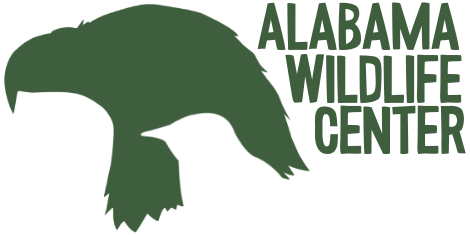Meet our Educational Ambassadors!
COOSA
Barred Owl
Strix varia
In 2001, Coosa came to AWC as a nestling – making him our oldest education bird! He was discovered on the ground with a large abdominal wound – likely from a predator attack. This wound left Coosa with extensive damage to his right leg muscle, deeming him as non-releasable.
Barred Owls are a medium sized owl, and are named for the vertical brown ‘bar’ patterns on their chest. These owls have a very distinct call – “who cooks for you, who cooks for all” – giving them the name of ‘hoot owl.’ Barred Owls are commonly found in mature woods near a water source, where they’ve been known to catch fish and crayfish.
NOIR
Black Vulture
Coragyps atratus
Noir, a 2-year-old Black Vulture, joined us from the Raptor Rehab of Kentucky. He was taken from his nest as a baby and had been raised by humans. This caused Noir to become imprinted on humans – making him non-releasable.
Black Vultures are fascinating birds of prey with a distinctive appearance and a critical ecological role. Native to the Americas, they thrive in diverse environments from forests to urban areas, spanning from the southeastern U.S. to South America. As scavengers, they are essential for ecosystem health, consuming carrion and thus helping to prevent the spread of disease. Their strong beaks allow them to tear through tough hides, and their keen eyesight helps them spot food from afar.
GOLDIE
Red-Tailed Hawk
Buteo jamaicensis
Goldie came to the AWC as a first year bird after a vehicle accidentally hit her in 2015. The vehicle collision left her with permanent vision loss in her right eye, deeming her as non-releasable.
Red-Tailed Hawks are a large sized bird that is famous for its call. This is the largest and most abundant hawk in Alabama. These birds are found in open fields, perched and waiting to swoop down and grab prey with its talons. Adult Red-Tailed Hawks are identifiable by their red tails and dark belly band.
ATLAS
Eurasian Eagle Owl
Bubo bubo
In 2016, Atlas arrived at the AWC after being confiscated from a man in Wyoming who had purchased him through the exotic pet trade. Due to him being raised around a human at such a young age, he has imprinted on humans and cannot survive in the wild.
Eurasian Eagle Owls are a very impressive species – being one of the largest owl species on the planet. These birds are found in Europe, Asia, and parts of North Africa. Eurasian Eagle Owls mostly prey on small mammals and reptiles, but are known to take down prey over 35 lbs.
ROCKET
Red-Shouldered Hawk
Buteo lineatus
Rocket came to the AWC in 2018 as a first-year bird. After flying into a window, Rocket was left with permanent vision damage, making him unfit to be released into the wild again.
Red-Shouldered Hawks are a medium-sized raptor that is extremely vocal. In Alabama, these hawks are very abundant and found in wetland habitats. The diet for these hawks consists of mammals, reptiles, birds, and amphibians. Adult Red-Shouldered hawks are easily identifiable by their rufous chest and black and white banded tail.
SHELBY
Bald Eagle
Haliaeetus leucocephalus
Shelby was hit by a car in Washington and was transferred to Rowena Wildlife Center in The Dalles, Oregon. The vehicle collision had caused permanent blindness in her left eye. Shelby was then transferred to AWC in 2018.
When perching, Bald Eagles have a preference for deciduous or coniferous forests to have a view of their surroundings. The diet of a Bald Eagle is diverse – ranging from fish, small mammals, reptiles, amphibians, and even other birds. While once endangered, Bald Eagle populations have been growing due to dedicated conservation efforts.
DR. JENKINS – “DJ”
Great Horned Owl
Bubo virginianus
DJ came to us in 2020 as a nestling with a head tilt, indicative of head trauma that was likely caused by falling out of a tree. While some birds can ‘grow out’ of their head tilt, DJ never did, leaving him non-releasable.
Great Horned Owls are the largest owl species in Alabama. They are fierce predators of small to medium sized mammals, reptiles, and even raptors. These owls are very active at dusk and before dawn. Great Horned Owls are easily identifiable by their yellow eyes and feather tufts on the top of their heads.
LOLA
Eastern Screech Owl
Megascops asio
Lola came to us in 2021 after being hit by a vehicle. The collision caused a break in her right wing that hinders her flight capability. Because of this, she was deemed as non-releasable.
Eastern Screech Owls are the smallest species of owl in the eastern North America. Their color morphs are grey and red; in Alabama, the red morph is more common. The vocalizations of an Eastern Screech Owl vocalizations range from trilling to a “whinny” call, but do not have a true hoot that is often associated with an owl. Eastern Screech Owls have a varied diet, eating anything from insects to rodents to other birds.
BETTY WHITE
Red-Tailed Hawk (Leucistic)
Buteo jamaicensis
Betty White came to AWC in December 2021. She suffered from a severe humeral fracture to the right wing and an upper respiratory infection due to aspergillosis (a fungal infection). Although her wing healed, the aspergillosis caused significant lung scarring, resulting in shortness of breath from short flight distances. She has been deemed as non-releasable.
Leucism is a condition that causes a reduction of all pigment types rather than only melanin. Leucistic animals may have pattern colorations of white, pale/muted, or white patches. Betty White is a phenomenal example of leucism in animals!
MONTY
Mississippi Kite
Ictinia mississippiensis
Monty came to AWC the spring of 2022. He was found on the ground in Montevallo. Unfortunately, he suffered from soft tissue damage which led to permanent scarring on his right wing that prevents full wing expansion. Due to this, he was deemed as non-releasable.
Mississippi Kites are known to be graceful fliers as they swoop, glide, and circle their prey. Their diet consists of beetles, grasshoppers, frogs, lizards, snakes, small birds, and more. On the east side of the Mississippi River, Mississippi Kites often nest in mature, low-lying forests.
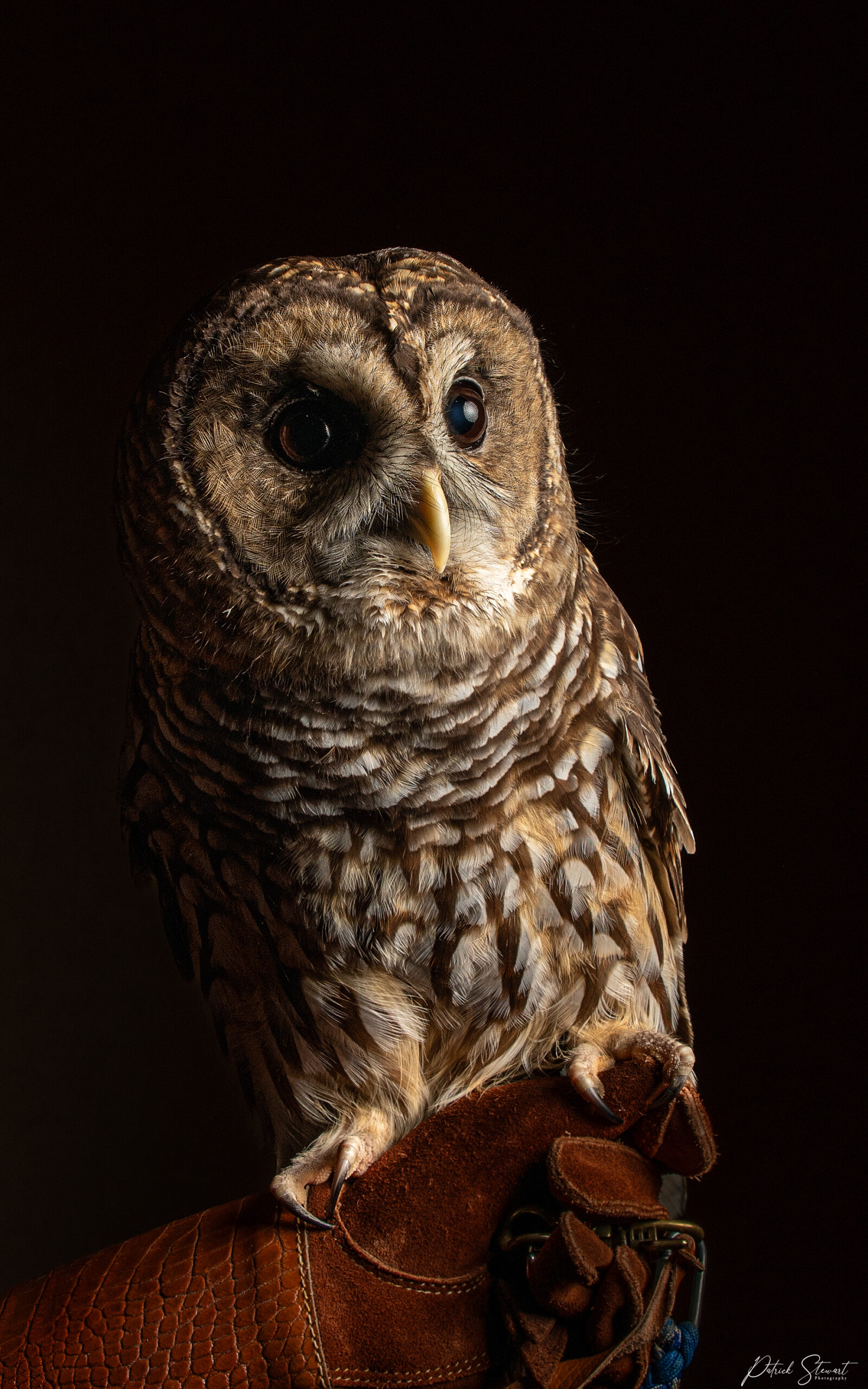
COOSA
Barred Owl
Strix varia
In 2001, Coosa came to AWC as a nestling – making him our oldest education bird! He was discovered on the ground with a large abdominal wound – likely from a predator attack. This wound left Coosa with extensive damage to his right leg muscle, deeming him as non-releasable.
Barred Owls are a medium sized owl, and are named for the vertical brown ‘bar’ patterns on their chest. These owls have a very distinct call – “who cooks for you, who cooks for all” – giving them the name of ‘hoot owl.’ Barred Owls are commonly found in mature woods near a water source, where they’ve been known to catch fish and crayfish.

ARTHUR
Merlin
Falco columbarius
Arthur came to us in 2013 after accidentally being shot in the wing by a dove hunter near the Mississippi border. His right wing suffered from permanent damage that restricts his ability to fly. The permanent damage eventually led to him needing his right wing to be partially amputated.
Merlins are small falcons that are only slightly larger than American Kestrels. They are commonly found in open forests, grasslands, and coastal areas during migration. In Alabama, Merlins are only found during migration. Similar to other falcons, their diet often includes other birds. While they may be small, Merlins are fierce predators and often use surprise attacks to take down prey.

GOLDIE
Red-Tailed Hawk
Buteo jamaicensis
Goldie came to the AWC as a first year bird after a vehicle accidentally hit her in 2015. The vehicle collision left her with permanent vision loss in her right eye, deeming her as non-releasable.
Red-Tailed Hawks are a large sized bird that is famous for its call. This is the largest and most abundant hawk in Alabama. These birds are found in open fields, perched and waiting to swoop down and grab prey with its talons. Adult Red-Tailed Hawks are identifiable by their red tails and dark belly band.
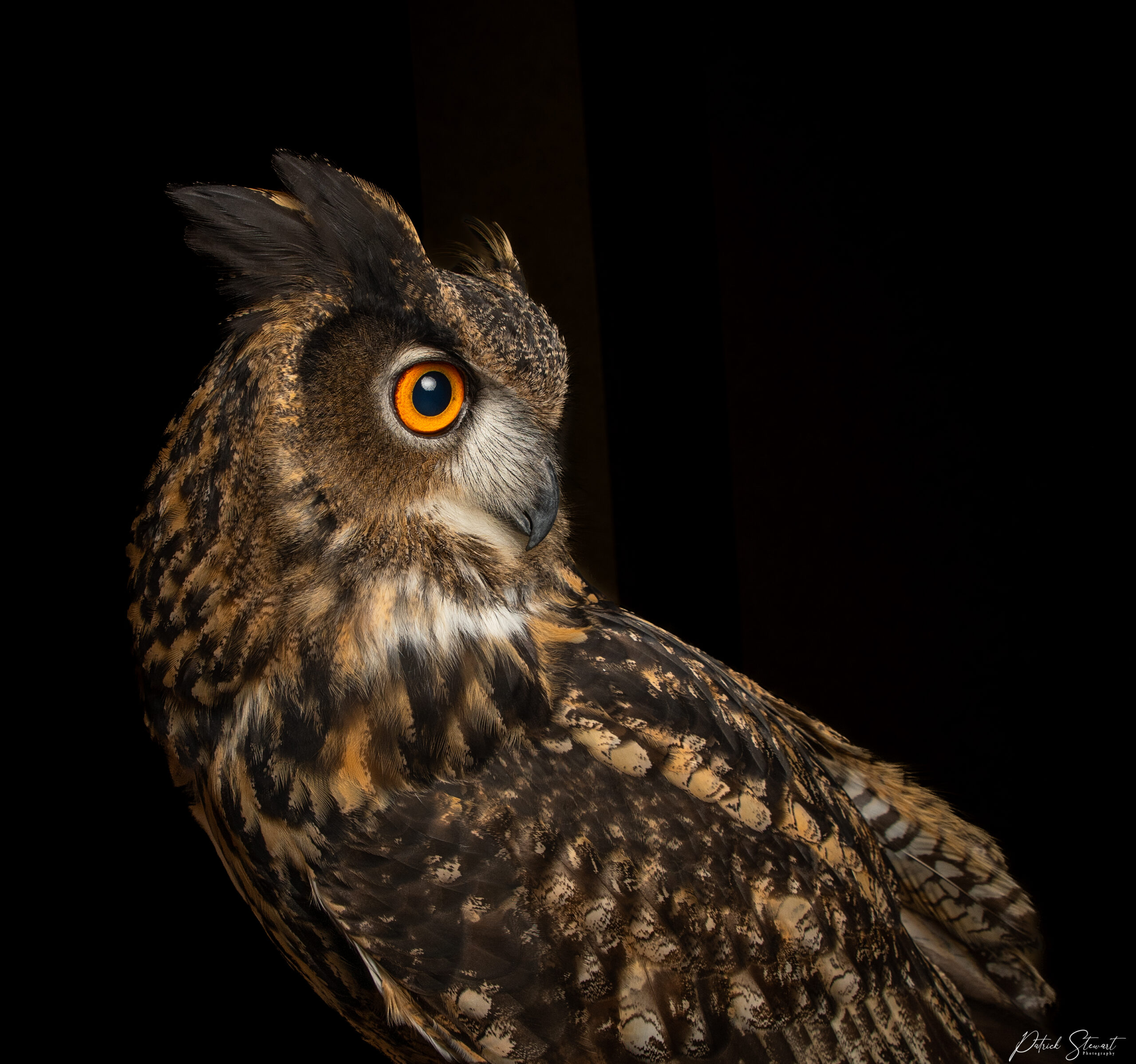
ATLAS
Eurasian Eagle Owl
Bubo bubo
In 2016, Atlas arrived at the AWC after being confiscated from a man in Wyoming who had purchased him through the exotic pet trade. Due to him being raised around a human at such a young age, he has imprinted on humans and cannot survive in the wild.
Eurasian Eagle Owls are a very impressive species – being one of the largest owl species on the planet. These birds are found in Europe, Asia, and parts of North Africa. Eurasian Eagle Owls mostly prey on small mammals and reptiles, but are known to take down prey over 35 lbs.

ROCKET
Red-Shouldered Hawk
Buteo lineatus
Rocket came to the AWC in 2018 as a first-year bird. After flying into a window, Rocket was left with permanent vision damage, making him unfit to be released into the wild again.
Red-Shouldered Hawks are a medium-sized raptor that is extremely vocal. In Alabama, these hawks are very abundant and found in wetland habitats. The diet for these hawks consists of mammals, reptiles, birds, and amphibians. Adult Red-Shouldered hawks are easily identifiable by their rufous chest and black and white banded tail.
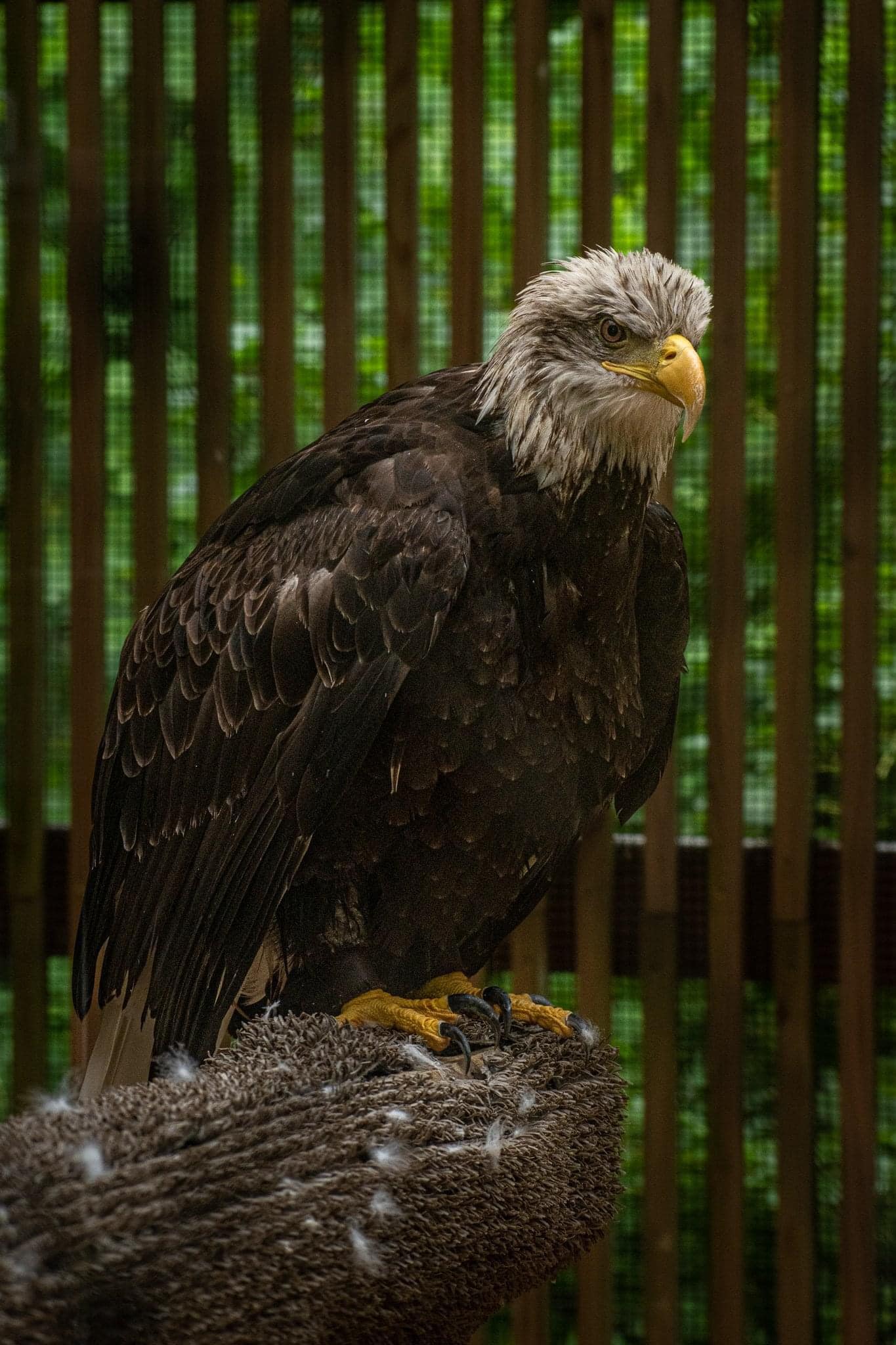
SHELBY
Bald Eagle
Haliaeetus leucocephalus
Shelby was hit by a car in Washington and was transferred to Rowena Wildlife Center in The Dalles, Oregon. The vehicle collision had caused permanent blindness in her left eye. Shelby was then transferred to AWC in 2018.
When perching, Bald Eagles have a preference for deciduous or coniferous forests to have a view of their surroundings. The diet of a Bald Eagle is diverse – ranging from fish, small mammals, reptiles, amphibians, and even other birds. While once endangered, Bald Eagle populations have been growing due to dedicated conservation efforts.
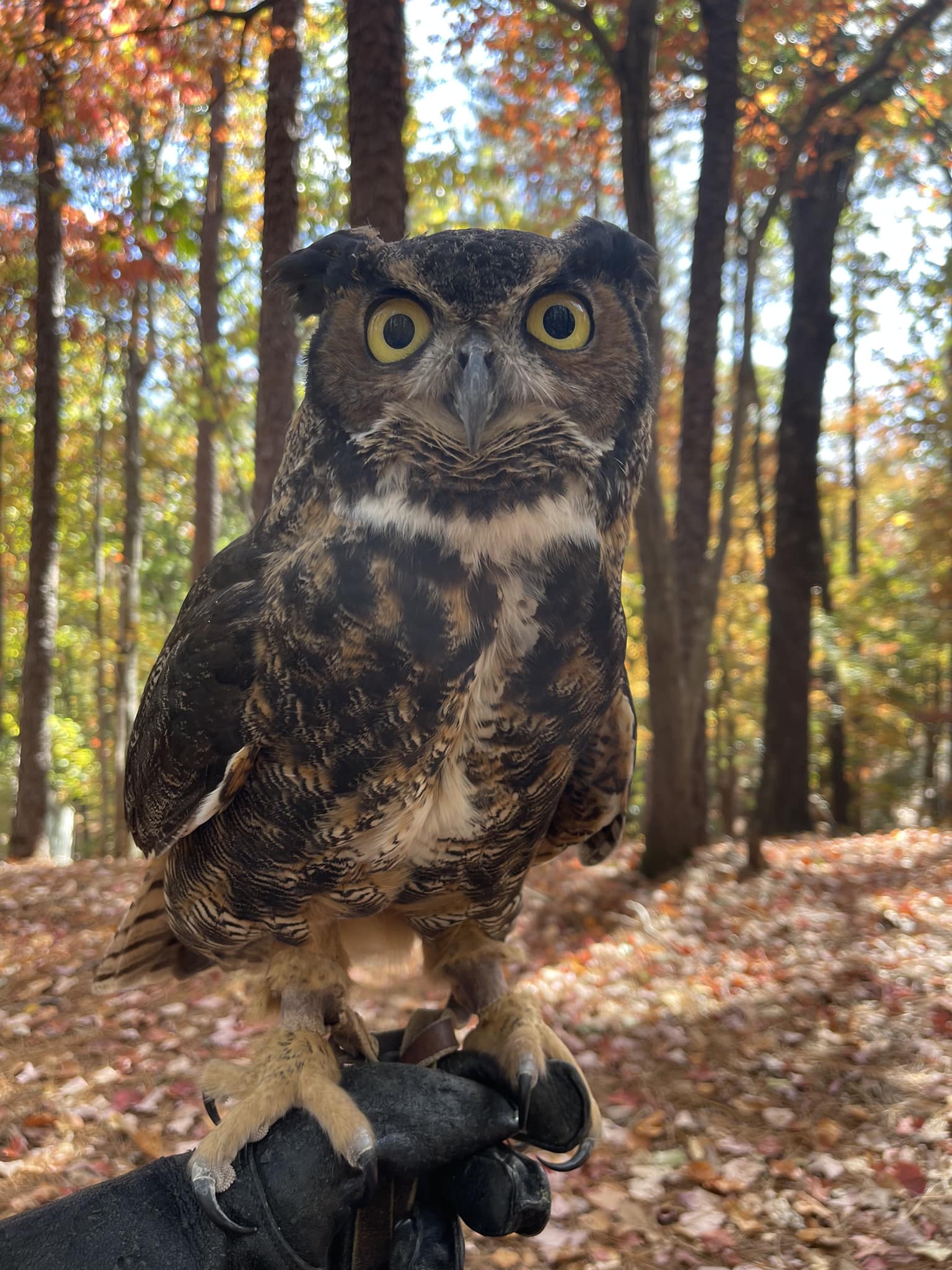
DR. JENKINS – “DJ”
Great Horned Owl
Bubo virginianus
DJ came to us in 2020 as a nestling with a head tilt, indicative of head trauma that was likely caused by falling out of a tree. While some birds can ‘grow out’ of their head tilt, DJ never did, leaving him non-releasable.
Great Horned Owls are the largest owl species in Alabama. They are fierce predators of small to medium sized mammals, reptiles, and even raptors. These owls are very active at dusk and before dawn. Great Horned Owls are easily identifiable by their yellow eyes and feather tufts on the top of their heads.

LOLA
Eastern Screech Owl
Megascops asio
Lola came to us in 2021 after being hit by a vehicle. The collision caused a break in her right wing that hinders her flight capability. Because of this, she was deemed as non-releasable.
Eastern Screech Owls are the smallest species of owl in the eastern North America. Their color morphs are grey and red; in Alabama, the red morph is more common. The vocalizations of an Eastern Screech Owl vocalizations range from trilling to a “whinny” call, but do not have a true hoot that is often associated with an owl. Eastern Screech Owls have a varied diet, eating anything from insects to rodents to other birds.
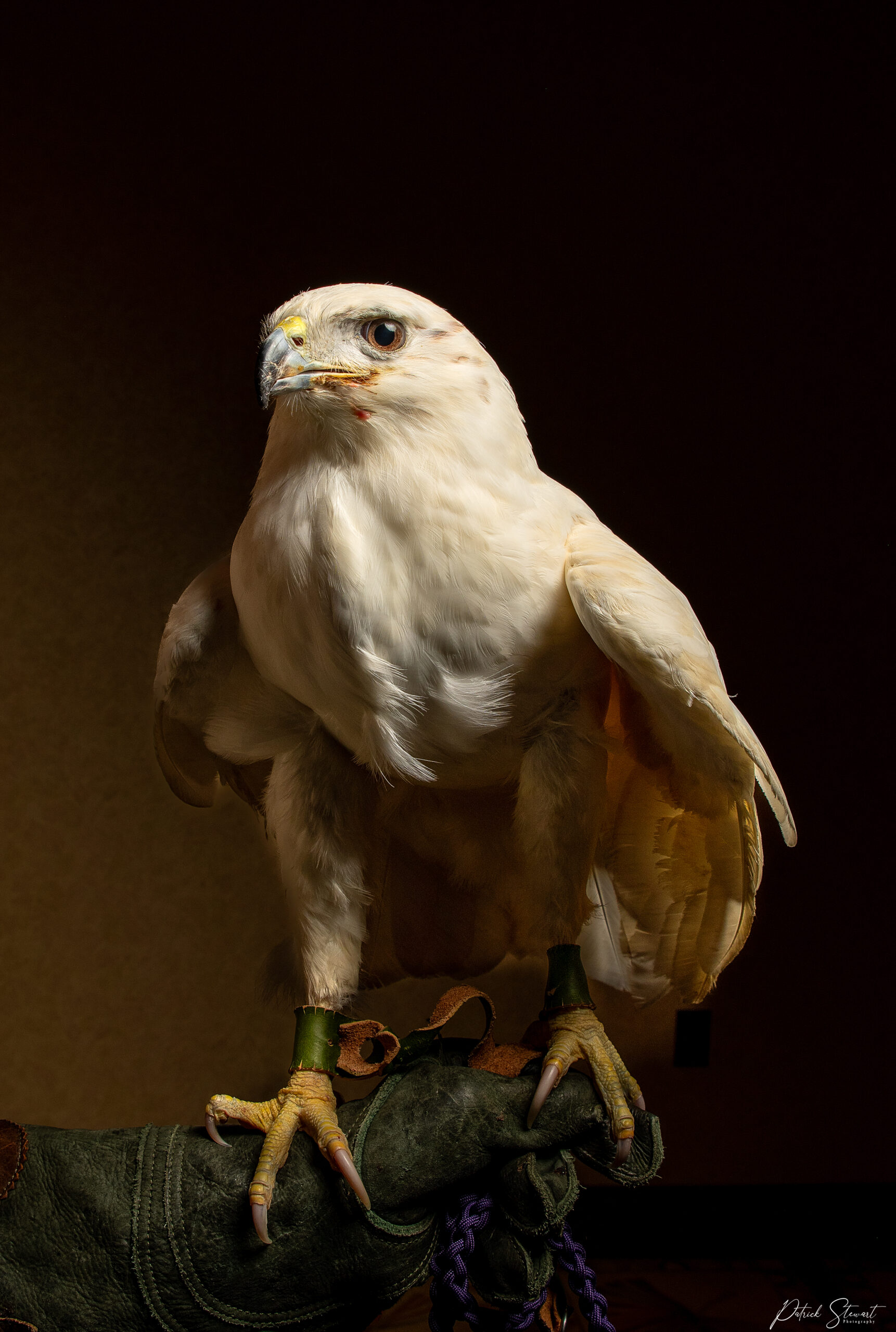
BETTY WHITE
Red-Tailed Hawk (Leucistic)
Buteo jamaicensis
Betty White came to AWC in December 2021. She suffered from a severe humeral fracture to the right wing and an upper respiratory infection due to aspergillosis (a fungal infection). Although her wing healed, the aspergillosis caused significant lung scarring, resulting in shortness of breath from short flight distances. She has been deemed as non-releasable.
Leucism is a condition that causes a reduction of all pigment types rather than only melanin. Leucistic animals may have pattern colorations of white, pale/muted, or white patches. Betty White is a phenomenal example of leucism in animals!
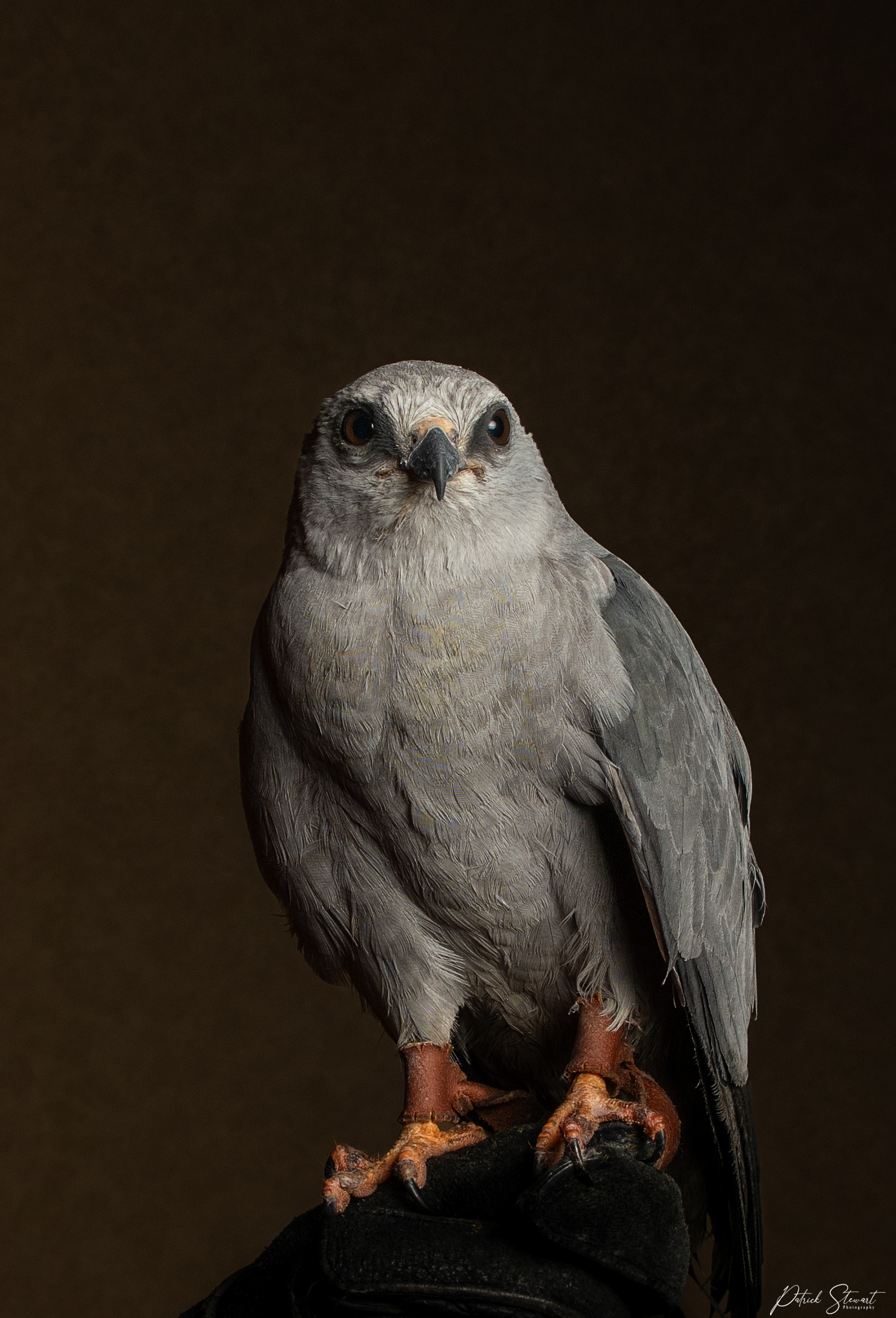
MONTY
Mississippi Kite
Ictinia mississippiensis
Monty came to AWC the spring of 2022. He was found on the ground in Montevallo. Unfortunately, he suffered from soft tissue damage which led to permanent scarring on his right wing that prevents full wing expansion. Due to this, he was deemed as non-releasable.
Mississippi Kites are known to be graceful fliers as they swoop, glide, and circle their prey. Their diet consists of beetles, grasshoppers, frogs, lizards, snakes, small birds, and more. On the east side of the Mississippi River, Mississippi Kites often nest in mature, low-lying forests.
